Rodney Green
Drums From the Church
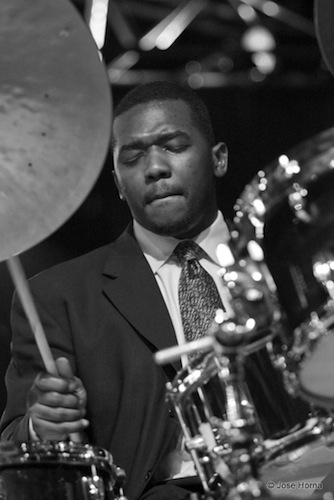
Born
on March 17, 1979 in Camden, NJ, Rodney Green is a "natural
drummer”. His father being a minister and an organist, he learned
to play drums at the church, where he spent most of his time during
his childhood. As a self-taught drummer, he forged his own style far
from music schools and university programs, listening to records and
then completing his training at 15 on stage with some of the best
musicians of Philadelphia. Shortly after that, Bobby Watson hired him
for a tour in Italy. At 17, while he was still in high school, Rodney
Green had regularly gigs in New York and abroad. After his
graduation, he moved to New York and soon played and recorded with
Greg Osby, Christian McBride, Eric Reed, Joe Henderson, Benny Green,
Tom Harrell and Mulgrew Miller. At 19, on Ben Wolfe’s
recommendation, the drummer joined Diana Krall’s band and stayed
for two years. Today, at 35, with a 20-years’ experience and a lot
of records as a sideman, Rodney Green has played with some of the
most important jazz musicians: Charlie Haden, Terell Stafford,
Wycliffe Gordon, Betty Carter, Abbey Lincoln, Dianne Reeves, Wynton
Marsalis, etc.
We met Rodney Green while he was playing in Paris with
the Benny Green Trio, featuring also David Wong (b).
Interview by Jérôme Partage
Photos José M. Horna
© Jazz Hot #669, Autumn 2014
Jazz
Hot: You started to play drums at 3 at the church?
Rodney
Green: My father was a minister and a
gospel teacher. When I saw the drums at the church, they were
shining. And I said: "Ok, let’s play some drums”. My father
plays piano, my mother sings. When I got involved into music I wasn’t
supposed to play jazz. It was the devil’s music! But I heard some
jazz… and here I am! In every memory I have, I play the drums. I
didn’t take my first drum lesson until I was 14 years old and it
was because I needed to learn how to read music. I wanted to be in
concert bands, in school bands, and so it was necessary.
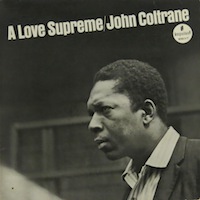
So,
you first learned music by ear?
Yes.
But even if you read music, you still learn it by ear. I just watched
drummers at church or on television. There’s also a magazine called
Modern Drummer,
and I learned a lot by looking at the pictures: "Oh, look at this
guy, his fingers are here. This one holds his sticks that way”. My
first idol was Tony Williams, because I read he was only 17 when he
started with Miles. I was 14 and I told to myself: "He did it. I
can do it too!” So, I bought all his records. First I discovered
jazz by fusion. I liked guys like Dave Weckl, Chick Corea’s
drummer. Then, by getting into the music, I heard Elvin Jones. My
cousin, who is a tenor saxophone player, put on a John Coltrane
record. And for the first time, I heard mallets and I said: "Wow!
What is all that?”; because I only knew about fusion drummers and
sticks. These guys had big drum sets, with four or five tom-toms,
seven cymbals, etc. So, 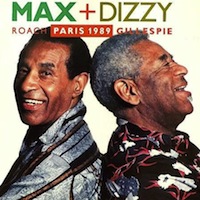 when I heard Elvin Jones getting all these
sounds, I said: "Man, his drum set must be huge!” And I took the
record, there was a picture on the back. It was the smallest drum set
I had ever seen, just two tom-toms and two cymbals. So, I said: "Ok.
He must be better.” Since then, I am fascinated by drummers using
very small set and getting different sounds by mallets, sticks, brush
or their hands. After I heard Elvin Jones, I wanted to get mallets.
It was like if they had been there all the time and I never looked at
them. The next record my cousin played to me was a duet between Dizzy
Gillespie and Max Roach that they made in the 1980s. That made me
realize that drums can do more than I thought. Later, I heard Vernel
Fournier play the brushes with Ahmad Jamal. And the first time I
heard the sizzle cymbal, I really liked that but I didn’t know how
to get that sound. It was very exciting. I’m still dealing with
that now. The cymbals I play with today are designed and I’m still
learning about how they go. I buy drum sticks but I customize them
myself because I can get other sounds if the stick is cut this way or
if I use sandpaper or knives. when I heard Elvin Jones getting all these
sounds, I said: "Man, his drum set must be huge!” And I took the
record, there was a picture on the back. It was the smallest drum set
I had ever seen, just two tom-toms and two cymbals. So, I said: "Ok.
He must be better.” Since then, I am fascinated by drummers using
very small set and getting different sounds by mallets, sticks, brush
or their hands. After I heard Elvin Jones, I wanted to get mallets.
It was like if they had been there all the time and I never looked at
them. The next record my cousin played to me was a duet between Dizzy
Gillespie and Max Roach that they made in the 1980s. That made me
realize that drums can do more than I thought. Later, I heard Vernel
Fournier play the brushes with Ahmad Jamal. And the first time I
heard the sizzle cymbal, I really liked that but I didn’t know how
to get that sound. It was very exciting. I’m still dealing with
that now. The cymbals I play with today are designed and I’m still
learning about how they go. I buy drum sticks but I customize them
myself because I can get other sounds if the stick is cut this way or
if I use sandpaper or knives.
At
14, percussionist Scott Robinson gave you your first lesson?
Yes!
He was a great teacher. He gave me the technique for playing jazz. He
made me listen to Buddy Rich and some other drummers. He told me:
"There’s a lot of schools, a lot of tunes. You have to go through
now. No more just sitting in a room and playing drums. You have to
work on brushes technique, mallets technique, to learn how to switch
from mallets to sticks, etc.”
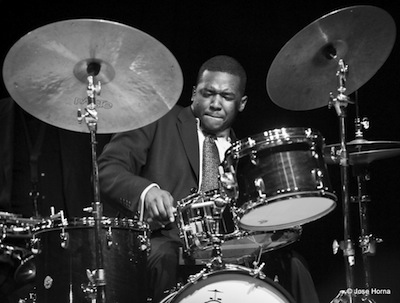
When
did you decide to become a professional musician?
My
cousin made me understand two very important things. First, he made
me listen to Elvin Jones. Second, he was the first one to let me know
that you can make money with playing music. I had no idea of that. It
was something I did in a natural way, like the kids in Europe play
soccer.
And
when did you have your first gigs?
I
had a girlfriend who was older. So she could drive and she drove me
to different clubs. We were supposed to have a date and to go to the
cinema, instead we went to jam sessions and sit-in to get a gig. And
she took me to gigs at the little club of my town. And then, I
started going to Philadelphia, playing with the older guys. That’s
where I really learned the tunes, their names, the records, the terms
"bebop”, "hard bop”, how to take a solo, etc. I played with
Bootsie Barnes, Orrin Evans, Duane Eubanks, Stefon Harris… All
these guys were very nice, spent time with me and explained the
little details to me. It was something, man! After what, you can say:
"Ok, let’s go to the next level, let’s go to New York!”;
because you can get too comfortable by staying in Philly. You have
your connections, you buy a house, etc. So I went to New York at 17.
No college. I just took my drums and played. I had a job at Patti
LaBelle’s club, "Chez LaBelle”. She is a R&B singer and she
has a TV show. So I save money thanks to this job and I went to New
York. Philly and New York are so close! Just an hour and a half by
car. But it’s another world in terms of quality of musicians and
opportunities.

Until
you moved to New York, were you still in high school?
Yes.
I had a beeper. And when I received a message for a gig, I had to ask
to go to the men’s room to answer! I was around and a lot of people
liked me. I had a lot of opportunities. The thing is to answer the
phone before another guy answers the phone and always say yes. I
understood this early. I learned a lot very quickly. My great
advantage was that I didn’t go to college. I was like four years
ahead of people of my generation who graduated from college because I
was already working and musicians knew me. They thought I was older.
I was always in bands where everybody was five or six years older
than me. That’s all changed! (Laughs)
Who
did you play with when you arrived in New York?
My
first gig was with Bobby Watson. Then, I played with Greg Osby. He
made what is still probably my most famous record, Banned
in New York. Then, Eric Reed and
Mulgrew Miller who I worked with from 18 until he died last year. He
was my man! I have a memory of being on stage with Joe Henderson.
Bill Stewart was playing after with John Scofield. We are friends. We
met in Philadelphia. I was 15 or 16 and he gave me his home number.
Musicians don’t do that. They give you their manager’s phone
number and just say: "Nice to meet you, kid.” So, I was on stage
with Joe Henderson. I was 19 years old. And Bill Stewart stood on the
side of the stage and watched me play. And then I thought: "This is
real!” 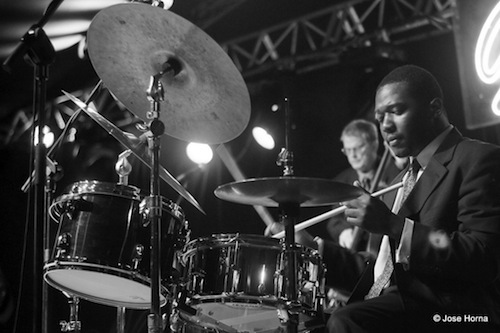
You
also played with Chris McBride…
I
played with him once or twice in the past. But I really met him when
I joined his band. They needed urgently a new drummer. I think they
called everybody! And finally somebody must have told them about me.
So, they called me and said: "You have to be on the plane
tomorrow!” That’s what I did… I remember being in studio with
Chris McBride and waiting around for Herbie Hancock for six hours. We
had to record two songs with him1. And when he came and rehearsed with
us, I thought about all these records he did in his career. Working
with Charlie Haden also was amazing. The level we played, how he
approached things… With Charlie, we played exactly the same set for
the all eight or nine years I’ve been in the band. Just six or
seven tunes. But each time, we were asking how it was possible to do
what Charlie was doing. It was the same thing for Joe Henderson.
What
sort of band do you prefer?
After
my first years, playing with everybody, the trio became my specialty.
I really like that. But it’s very different according to who you
play with. This trio with Benny Green is very different from the
trios I normally play with. It’s more like the Ray Bryant trio. The
arrangements must be played in the same way every night. So, my job
is to find new ways to play those 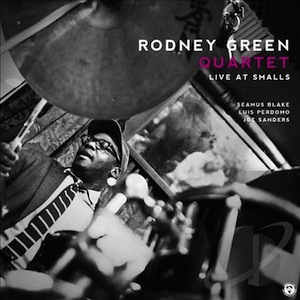 things, especially after Kenny
Washington who is extremely brilliant in this situation. So, I have
to play things that he has not already played. It’s difficult, but
I like it! And if you want to try something new, you have to convince
Benny and really believe in yourself. Last night, for a tune I always
play with brushes, I used the sticks. And it made the piece change.
And Benny said: "Oh, I like it with sticks!” That’s what
drummers are supposed to do in a band. When you think that Miles
played the same tunes with Tony Williams, Jimmy Cobb or Philly Jo
Jones… Each one found new ways. That’s the genius of the great
drummers. When John Coltrane was looking for something, he asked
Elvin Jones. The trust was strong. There was also something I would
more learn about: the audacity. It’s not arrogance. You have to
believe in yourself and say: "There’s another way”. Someday
someone will find something new as if it had always been there. And
it’s the same notes, the same rhythms, the same instruments, the
same tunes. That’s the magic of playing music. things, especially after Kenny
Washington who is extremely brilliant in this situation. So, I have
to play things that he has not already played. It’s difficult, but
I like it! And if you want to try something new, you have to convince
Benny and really believe in yourself. Last night, for a tune I always
play with brushes, I used the sticks. And it made the piece change.
And Benny said: "Oh, I like it with sticks!” That’s what
drummers are supposed to do in a band. When you think that Miles
played the same tunes with Tony Williams, Jimmy Cobb or Philly Jo
Jones… Each one found new ways. That’s the genius of the great
drummers. When John Coltrane was looking for something, he asked
Elvin Jones. The trust was strong. There was also something I would
more learn about: the audacity. It’s not arrogance. You have to
believe in yourself and say: "There’s another way”. Someday
someone will find something new as if it had always been there. And
it’s the same notes, the same rhythms, the same instruments, the
same tunes. That’s the magic of playing music.
Do
you have projects as a leader?
Last
year, I did my first record as a leader on SmallsLIVE. It’s a great
quartet with Seamus Blake, who is my all time favorite tenor
saxophone and one of my oldest friends, Joe Sanders and Luis Perdomo.
I made a couple of records with this rhythm section. Next year, I
hope to travel with great musicians like Benny Green, but on my own
project. I’m 35, I think it’s time!
Contact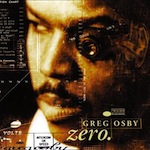
www.rodneygreenjazz.com
Discographie
Leader-coleader
CD. 2013. Live at
Smalls, Smalls Live 0036
Sideman CD. 1996. Denise
King, Simply Mellow, R.E.D.D. King Records 884502344479
CD. 1997. Patti
LaBelle, Flame, MCA 874966
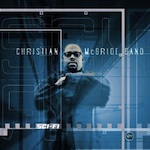 CD. 1998. Greg Osby,
Zero, Blue Note 93760 CD. 1998. Greg Osby,
Zero, Blue Note 93760
CD. 1998. Greg Osby,
Banned in New York, Blue Note 96860
CD. 1999. Walter
Blanding, The Olive Tree, Criss Cross Jazz 1186
CD. 1999. JD Allen,
In Search of, RED Distribution 123283
CD. 1999. Terell
Stafford, Fields of Gold, Nagel Heyer 2000
CD. 2000. Christian
McBride, SciFi, Verve 543915
CD. 2000. Eric Reed,
Happiness, Nagel Heyer 2010
CD. 2000. Jafar
Barron, Free Bop Movement, Q 92948
CD. 2000. Eric Reed,
E-Bop, Savant Records 2051
CD. 2002. Mulgrew
Miller, Live at the Kennedy Center. Volume One, MaxJazz 217
CD. 2002. Mulgrew
Miller, Live at the Kennedy Center. Volume Two, MaxJazz 219
CD. 2001. Wycliffe
Gordon, What You Dealin’ With, Criss Cross Jazz 1212
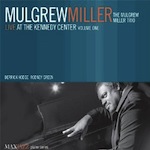 CD. 2003. Greg Osby,
St. Louis Shoes, Blue Note 81699 CD. 2003. Greg Osby,
St. Louis Shoes, Blue Note 81699
CD. 2003. Eric Reed,
Merry Magic, Max Jazz 302
CD. 2004. Orrin
Evans, Easy Now, Criss Cross Jazz 1259
CD. 2004. Greg Osby,
Public, Blue Note 97683
CD. 2004. Daisuke
Abe, My Way Back Home, Nagel Heyer 2061
CD. 2006. John
Stetch, Bruxin’, Justin Time 8525
CD. 2008. Adam
Birnbaum, Travels, Smalls 38
CD. 2008. Antonio
Ciacca, Rush Life, Motéma Music 15
CD. 2009. Terell
Stafford – Dick Oatts Quintet, Bridging the Gap, Planet Arts 330974
CD. 2009. Eric Reed,
Something Beautiful, WJ3 31009
CD. 2010. Christian
Winther, From the Sound Up, SteepleChase 31721
CD. 2010. Peter Zak,
Down East, SteepleChase 31715
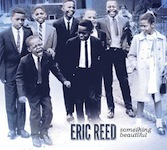 CD. 2010. Harold
O’Neal, Whirling Mantis, Smalls 48 CD. 2010. Harold
O’Neal, Whirling Mantis, Smalls 48
CD. 2010. Charlie
Haden, Sophisticated Lady, Decca 01534702
CD. 2010. Melissa
Stylianou, Silent Movie, Anzic 36
CD. 2011. Joe
Sanders, Introducing Joe Sanders, Criss Cross Jazz 1344
CD. 2011. John
Ellis, It’s You I Like, Criss Cross Jazz 1347
CD. 2012. Michael
Rodriguez, Reverence, Criss Cross Jazz 1356
CD. 2012. Dick
Oatts, Lookin’ Up, SteepleChase 31738
CD. 2012. Laurent
Courthaliac, Pannonica, Jazz Village 570023
CD. 2013. Tim
Warfield, Inspire Me !, Herb Harris Music
CD. 2013. Luis
Perdomo, Links, Criss Cross Jazz 1357
CD. 2013. John Ellis
/ Andy Bragen, Parade Light Records 001
Vidéos
Rodney Green au
Festival Jazz Baltica 2006 avec Mulgrew Miller (p), Ivan Taylor (b)
et Stefano Di Battista (as)
Rodney Green au Hat
Bar (Saint-Petersbourg, Russie) avec Bill Charlap (p) et Peter
Washington (b)
Rodney Green en solo
aux Hot Jazz Series (2011)
*
|

